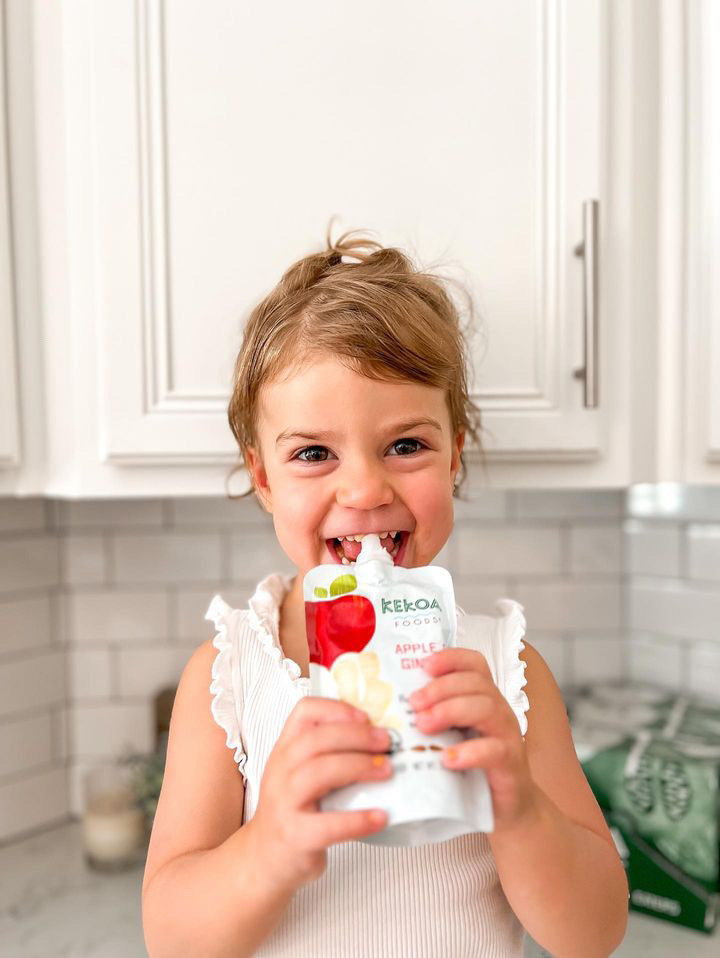
What is Taste Training™?

What is Taste Training™?
At Kekoa Foods, we believe that just like sleep and potty training, Taste Training should be a fundamental part of raising and caring for your little one. Taste Training is about introducing diverse flavors early on to help shape a healthy and adventurous eater. By doing this, you can prevent fussiness about new foods and encourage your child to enjoy meals beyond the unhealthy options often found on children's menus at many restaurants.
Understanding Taste Training™
Taste Training is the process of systematically introducing your baby to a variety of flavors and textures. This approach encourages them to embrace different foods, reducing the likelihood of picky eating as they grow. It’s akin to sleep or potty training in that it requires patience, consistency, and repetition to establish lasting habits.
The idea behind Taste Training is rooted in the concept of flavor acceptance through repeated exposure. Research from the National Institutes of Health highlights that early and varied flavor exposure can significantly impact a child’s willingness to try and enjoy a broader range of foods later in life. The study found that infants exposed to a variety of flavors were more likely to accept those flavors later on. By making diverse foods a regular part of your child’s diet from an early age, you’re setting the stage for a lifetime of healthy eating habits.
Humans have an in-born, evolutionary propensity to like sweet tasting foods. This is because our brains are wired to connect sweet things with safety. If you think back to when our ancestors had to forage for food, sweet fruits were safe, whereas sour fruit was probably spoiled and not safe to eat. Also, breastmilk and baby formula are sweet. Since liking sweets is pretty much automatic, with Taste Training, we aim to start with less sweet flavors overall, to get your baby’s taste preference varied. By introducing sweet flavors towards the end of training, and pairing them with complex flavors and spices, babies grow to accept new foods as they’re offered later in development and tend to have a lower tolerance for sweet-tasting foods.
Created in Partnership with Dr. Nicole Avena
Dr. Nicole Avena is a research neuroscientist and expert in the fields of nutrition, diet and addiction, with a special focus on nutrition during the lifespan. She has done groundbreaking work developing models to characterize food addiction and the dangers of excess sugar intake. She graduated from Princeton University with a PhD in Psychology and Neuroscience, and completed her postdoctoral fellowship in molecular biology at The Rockefeller University in New York City. Her research achievements have been honored by awards from several groups including the New York Academy of Sciences, the American Psychological Association, and the National Institute on Drug Abuse. In addition to over 100 peer-reviewed scholarly publications, Dr. Avena has written several popular books, including Why Diets Fail: Because You’re Addicted to Sugar, What to Eat When You’re Pregnant, What to Feed Your Baby and Toddler and What to Eat When You Want to Get Pregnant. Her latest book, Sugarless, covers the latest science on sugar addiction and how to overcome it. She frequently appears as a science expert in the media, including regular appearances on Good Day NY, Good Morning America, and the former Dr. Oz Show as well as many news programs. Her work has been featured in Time Magazine, Bloomberg Business Week, The New York Times, and many other periodicals. Dr. Avena is a member of the Penguin Random House Speakers Bureau. She has the #2 most watched TED-ED Health talk, How Sugar Affects Your Brain, with over 17 million views and counting.

Why Training Matters
Similar to the other training parents provide to their children, Taste Training is all about teaching and coaching your children to adopt routines that lead to better habits. The repetitive nature of introducing new flavors helps to build greater familiarity and eventually acceptance. Here’s why this is so important to your child’s development:
Reduces Picky Eating
-------
Children are more likely to accept new foods if they’ve been exposed to a wide variety of flavors early on. Taste Training helps mitigate picky eating behaviors, making mealtimes less stressful for parents.
Promotes Nutritional Balance
-------
A diverse palate encourages a balanced diet. By introducing your baby to different fruits, vegetables, and spices, you’re ensuring they receive a broad spectrum of nutrients essential for their growth and development.
Encourages Cultural Awareness
------
Exposure to flavors from around the world from a young age helps to foster an appreciation for different cultures and cuisines. It’s a delicious way, for you and baby, to broaden culinary horizons and cultural understanding.
Supports Healthy Habits
------
Children who develop a taste for a variety of tastes and healthier foods are less likely to crave sugary, processed snacks. This is a healthy foundation upon which your children will realize better healthful outcomes as they grow.

The Process of Taste Training™
Like any other type of training, Taste Training is not a one-and done moment in time. It’s a continuous process that exercises your baby’s palate, creating a kind of taste muscle memory. This process helps transition your little one from a picky eater to one who routinely enjoys a wide range of flavors from vegetables, spices, and eclectic recipes from around the world. Here’s how you can embark on this flavorful journey with your child:
Ready to Get Your Little Ones Started?
We invite you to read on and continue learning about the incredible benefits of Taste Training. But, if you're ready to get started, you can hop on over to the Taste Training Bundles shopping page. There, you can get started with the Voyager, followed by the Explorer and Globetrotter bundles, today.
1
Start Early
------
Begin introducing new flavors as soon as your baby is ready for solid foods, typically around 6 months old. Starting early increases their receptiveness to different tastes.
2
Introduce Less Complex Flavors First
-------
Use flavors found in our Peas & Mint pouch to allow your baby to become familiar with new tastes in combinations their young palates can adapt to and enjoy more easily.
3
Gradually Mix Flavors
------
Once your baby shows signs of comfort with less complex flavor combinations, begin moving into more complex ones. Think of our Beets, Fennel, & Kale baby food purée pouch.
4
Incorporate
Mild Spices and Sweet Tastes
------
Gradually add mild spices to their diet, as well as foods that are sweet. Our Squash & Kale with Turmeric pouch introduces a hint of spice without overwhelming your baby’s palate. Our Apple & Ginger pouch encourages new flavors alongside a known sweet flavor.
5
Encourage Repetition
------
Consistency is key. Repeated exposure to a flavor can increase acceptance. Don’t be discouraged if your baby doesn’t take to a new taste immediately – keep offering it in small, enjoyable amounts. Research studies show that it can take up to 10 times of being exposed to a new taste before babies learn to trust it. This is because babies’ brains are constructed to be naturally wary of new tastes, another safety trait we humans inherited from our ancestors.
6
Celebrate Small Wins
------
Every new flavor your baby enjoys is a step forward. Celebrate these milestones and enjoy the journey of culinary discovery together.
Now Let's Talk About "Why Taste Training."
Now that you've become familiar with the "what", let's head over to the Why Taste Training section to learn about the multitude of benefits the program brings to healthfulness of your little ones.

